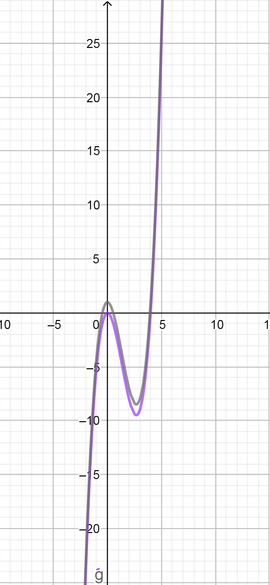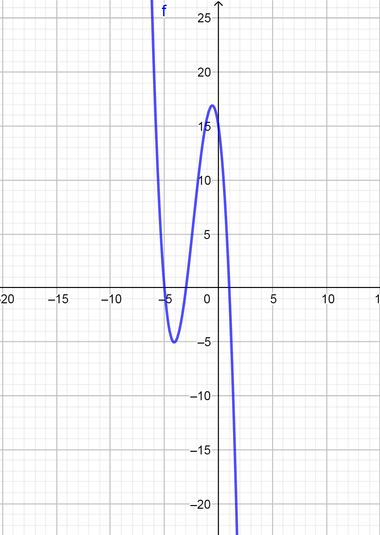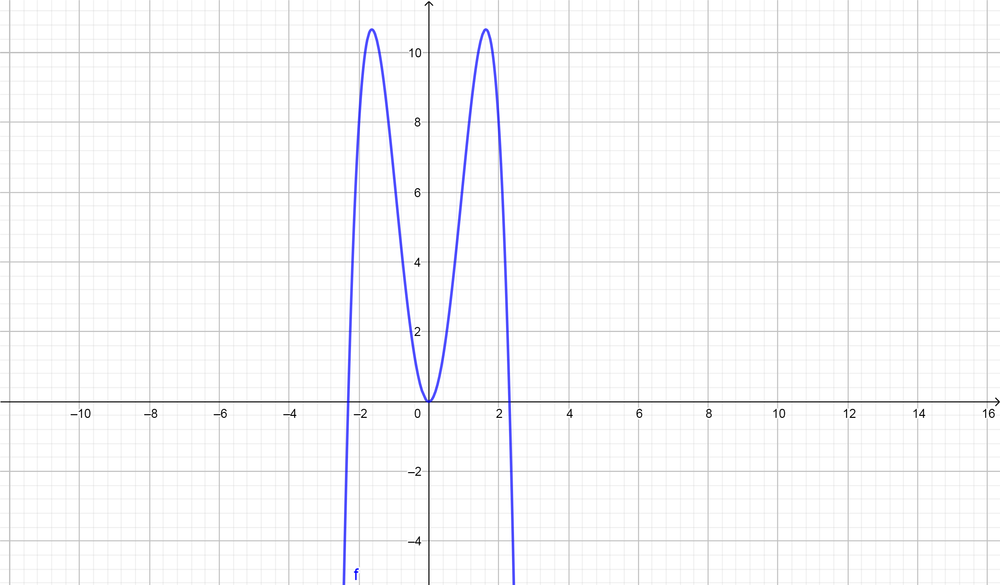
All Solutions
Page 186: Chapter Self-Test
(a) Write the standard equation of the polynomial function, then state the degree and leading coefficient.
Standard form is $y= ax+b$
For cubic function is $(y=ax^3+bx^2+cx+d)$ as follows:
$$
y=6x^3+x^2-12x+5
$$
Degree is $(n=3)$ Leading coefficient is $(6)$
(b) Write the greatest number of turning point that equation have.
This equation may have $(2)$ and $(0)$ turning points, so
the greatest one is $(2)$
This equation may have $(1, 2, 3)$ zeros, so
the greatest one is $(3)$
(d) If the least number of zeros is $(1)$ write the degree of the function.
The degree of the function that have least number of zeros is $(1)$ is cubic function $(n=3)$
text{color{Brown}a) $y=ax^3+bx^2+cx+d$ $y=6x^3+x^2-12x+5$
\ \
b) greatest one is $(2)$. c) greatest one is $(3)$. d) cubic function $(n=3).$}
$$
$$
text{color{#4257b2}From the graph:}
$$
This is a cubic function and zeros are:
$$
[x=-4 x=-2 x=2]
$$
The equation is $f(x)=(x+4)(x+2)(x-2)$
$$
f(x)=(x+4)(x^2-4)
$$
text{color{Brown} $f(x)=(x+4)(x^2-4)$}
$$
$$
color{#4257b2}text{(a)} 2x^3-x^2-145x-72
$$
Use greatest common factor as follows :
$$
x^2(2x-1)-72(2x-1)
$$
$$
(2x-1)(x^2-72)
$$
$$
color{#4257b2}text{(b)} (x-7)^3+(2x+3)^3
$$
According standard form $a^3+b^3=(a+b)(a^2-ab+b^2)$
$$
begin{align*}
(x-7)^3+(2x+3)^3 &=(x-7+2x+3)[(x-7)^2-((x-7)(2x+3))+(2x+3)^2]
\ \
&=(3x-4)[(x^2-14x+49)-(2x^2-11x-21)+(4x^2+12x+9)]
\ \
&=(3x-4)(x^2-14x+49-2x^2+11x+21+4x^2+12x+9)
end{align*}
$$
Rearrange the tiles to group like terms as follows:
$$
=(3x-4)[(x^2-2x^2+4x^2)+(-14x+11x+12x)+(49+21+9)]
$$
$$
=(3x-4)(3x^2+9x+79)
$$
text{color{Brown}(a) $(2x-1)(x^2-72)$
\ \
(b) $(3x-4)(3x^2+9x+79)$}
$$

The new function is $f(x)=x^3-4x^2+1$
According the graph has number of zeros more than the original function.
Zeros of the original function are $(x=0, x=4)$
Zeros of the new function are $(x=-0.5, x=0.5, x=4)$
text{color{Brown}The graph has number of zeros more than the original function.}
$$
$f(x)=-(x+3)(x+5)(x-1)$ below the $(x)$ axis.
From the graph the interval is $(-5le xle1)$

text{color{Brown} $(-5le xle1)$}
$$
Divided the first term for the two question s as follows:
$$
=dfrac{6x^3}{2x}=3x^2
$$
Then multiply it $(3x^2)$with $(2x-1)$ as follows:
$$
(3x^2)(2x-1)=6x^3-3x^2 text{reverse}=-6x^3+3x^2
$$
Subtract the reverse result with $(6x^3+x^2-12x+5)$ as follows:
$$
cancel 6x^3+x^2-12x+5cancel-6x^3+3x^2
$$
$$
4x^2-12x+5
$$
Divided the first term for the two question s as follows:
$$
=dfrac{4x^2}{2x}=2x
$$
Then multiply it $(2x)$with $(2x-1)$ as follows:
$$
=4x^2-2x text{reverse}=-4x^2+2x
$$
$$
cancel4x^2-12x+5cancel-4x^2+2x=0
$$
$$
-10x+5
$$
Divided the first term for the two question s as follows:
$$
=dfrac{-10x}{2x}=-5
$$
Then multiply it $(-5)$with $(2x-1)$ as follows:
$$
=-10x+5 text{reverse}=10x-5
$$
Subtract the reverse result with $(-10x+5)$ as follows:
$$
cancel-10xcancel+5+cancel10xcancel-5=0
$$
$$
(6x^3+x^2-12x+5)=(2x-1)(3x^2+2x-5)
$$
The term $(2x-1)$ is the factor of the dividend
text{color{Brown}$$(6x^3+x^2-12x+5)=(2x-1)(3x^2+2x-5)$$}
$$
$$
text{color{#4257b2}(a) Write the equation for transformed function.}
$$
Note that: $a=5 k=dfrac{1}{2} d=2 c=4$
Use standard form $y=a[k(x-d)]+c$
Parent function is $y=x^3$
$$
y=5left[dfrac{1}{2}(x-2)right]^3+4
$$
$$
text{color{#4257b2}(b) Determine the new points on the transformed function if $(1, 1)$ is a point on the parent function.}
$$
Substitute the value of $(x=1)$ on the transformed function to get the value of $(y)$ as follows:
$$
y=5left[dfrac{1}{2}(x-2)right]^3+4
$$
$$
y=5left[dfrac{1}{2}(1-2)right]^3+4
$$
$$
y=5left[dfrac{1}{2}(-1)right]^3+4
$$
$$
y=5left[-dfrac{1}{2}right]^3+4
$$
$$
y=5left[-dfrac{1}{8}right]+4
$$
$$
y=-dfrac{5}{8}+4 y=dfrac{-5+32}{8}
$$
$$
y=dfrac{27}{8} y=3.375
$$
The new point on the transformed function is $(1, 3.375)$
text{color{Brown}(a) $y=5left[dfrac{1}{2}(x-2)right]^3+4$ (b) $(1, 3.375)$}
$$
The equation is $x^4+3x^3-9x^2+6$
The answer was $x^3-2x^2+x-5$ and the reminder was $31$
$$
text{color{#4257b2}Note that:}
$$
$f(x)=$ divisor $cdot$ quotient + reminder
$x^4+3x^3-9x^2+6=$ advisor $(x^3-2x^2+x-5) +31$
$x^4+3x^3-9x^2+6-31=$ advisor $(x^3-2x^2+x-5)$
$x^4+3x^3-9x^2-25=$ advisor $(x^3-2x^2+x-5)$
Divisor$=x^4+3x^3-9x^2-25div x^3-2x^2+x-5$
Using the divided method to get the divided as follows:
Divided the first term for the two question s as follows:
$$
=dfrac{x^4}{x^3}=x
$$
$$
=x^4-2x^3+x^2-5x
$$
Subtract the result with $(x^4+3x^3-9x^2-25)$ as follows:
$$
cancel{-x^4}+2x^3-x^2+5xcancel{x^4}+3x^3-9x^2-25
$$
$$
5x^3-10x^2+5x-25
$$
Divided the first term for the two question s as follows:
$$
=dfrac{5x^3}{x^3}=5
$$
Then multiply it $(5)$with $(x^3-2x^2+x-5)$ as follows:
$$
=5x^3-10x^2+5x-25
$$
Subtract the result with $(5x^3-10x^2+5x-25)$ as follows:
$$
5x^3-10x^2+5x-25-5x^3+10x^2-5x+25=0
$$
Julie divided by $x+5$
text{color{Brown} Large $(x+5)$}
$$
Note that the one of zeros $(x=2)$ and absolute maximum $(8)$
Substitute the values of $(x=2, y=8)$ as follows:
$$
8=a(2)^4+8(2)^2 8=16a+32
$$
$$
16a=8-32 16a=-24
$$
Divide both of sides by $(16)$ as follows:
$$
a=dfrac{-24}{16} a=-1.5
$$
$$
color{#4257b2} -1.5x^4+8x^2
$$
Determine the greatest common factor as follows:
$$
-x^2 (1.5x^2-8)
$$
Use zero property as follows:
$$
-x^2=0 x^2=0 x=0
$$
$$
1.5x^2-8=0 1.5x^2=8
$$
Divide both of sides by $(1.5)$ as follows:
$$
x^2=dfrac{8}{1.5} x^2=5.33
$$
Use square root property as follows:
$$
sqrt{x^2}=sqrt{5.33} x=pm 2.309
$$

text{color{Brown}$a=-1.5$
\ \
Zeros are $[0, 2, 2.309, -2.039]$}
$$

